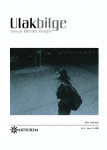RUS EDEBİYATINDA GOTİK ESTETİĞİN TEMEL KAVRAMLARI OLARAK YÜCE (SUBLIME) VE TEKİNSİZ (UNHEIMLICH)
SUBLIME AND UNCANNY AS FUNDAMENTAL CONCEPTS OF GOTHIC AESTHETICS IN RUSSIAN LITERATURE
Author(s): Duygu ÖzakınSubject(s): Aesthetics, Russian Literature, Theory of Literature
Published by: Sanat ve Dil Araştırmaları Enstitüsü
Keywords: Russian literature; Gothic; Karamzin; sublime; uncanny/unheimlich; aesthetics;
Summary/Abstract: This study examines historian and author Nikolay Karamzin’s (1766- 1826) tale “The Island of Bornholm”, which is considered to be the first example of Gothic fiction in Russian literature. Literary analysis of the text has been realized using concepts of the sublime and the uncanny, forming the two theoretical sources of Gothic theory in the fields of philosophy of art and psychology. Gothic has been the subject of aesthetics since it was used by Italian art historian Giorgio Vasari (1511-1574) as a pejorative adjective to describe the typical examples of medieval architecture. The sublime basing on the aesthetic conceptions of Irish philosopher Edmund Burke (1729-1797) and German philosopher Immanuel Kant (1724-1804) describes the thing that has qualities such as immensity, colossality or uncertainty though it is not traditionally beautiful. The sublime is the basis of Gothic theory and criticism as it is applied today, crossing with Sigmund Freud's (1856-1939) concept of the uncanny (unheimlich) in the field of psychology. The uncanny is the thing that ought to have remained hidden and secret, and yet comes to light. It refers something frightening and unreliable because not being familiar or not belonging to home.
Journal: Ulakbilge Sosyal Bilimler Dergisi
- Issue Year: 6/2018
- Issue No: 25
- Page Range: 687-701
- Page Count: 15
- Language: Turkish

